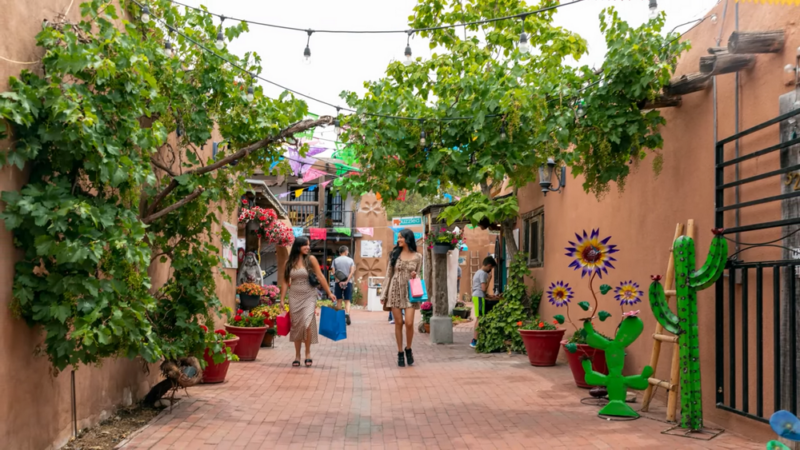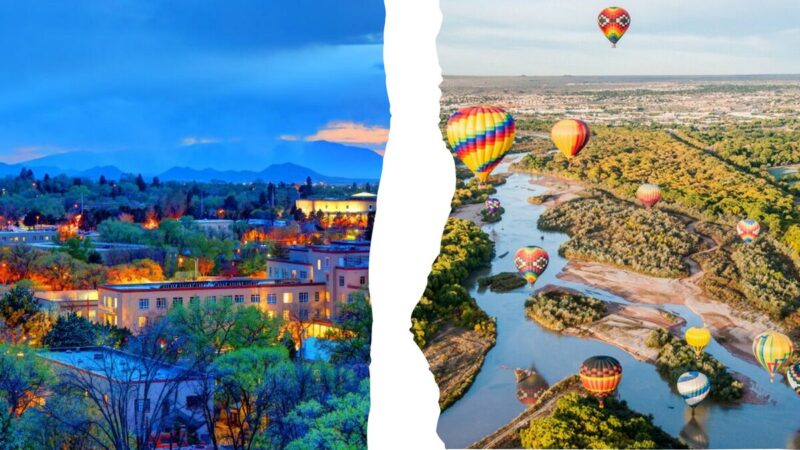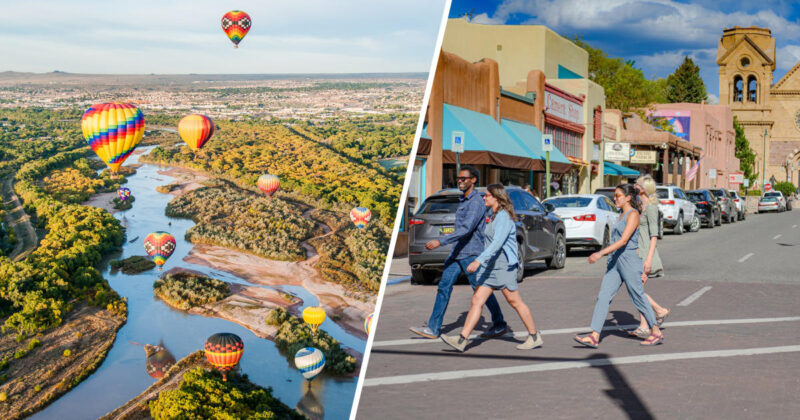Each city brings its unique flavor to New Mexico, offering different experiences. With its larger population, Albuquerque provides a more urban experience coupled with modern amenities, whereas Santa Fe offers a tranquil, historic setting steeped in tradition and culture.
Economic factors, lifestyle amenities, and the demographic makeup of these communities also play a critical role in shaping the life one can expect in either city.
Decision hinges on what one values more in their city of choice—Albuquerque’s city dynamics or Santa Fe’s sedate, culturally rich environment.
- “Better” is subjective and depends on individual preferences between Santa Fe’s cultural richness and Albuquerque’s urban vibrancy.
- Santa Fe presents a tranquil, historic atmosphere while Albuquerque offers a bustling city life.
- Economic factors, lifestyle amenities, and demographics significantly shape the living experience in each city.
Geographical Comparison
Climate and Landscape
Santa Fe, located at an elevation of approximately 7,000 feet, experiences cooler temperatures and more snowfall than Albuquerque, which sits nearly 5,000 feet above sea level. The higher altitude of Santa Fe results in a Mountain West climate, while Albuquerque has a desert climate, with hotter summers and milder winters. In terms of landscape, Santa Fe boasts nearby mountain ranges such as the Sangre de Cristo, providing a backdrop of dramatic peaks and outdoor activities, while Albuquerque is known for its striking mesa views and the Rio Grande running alongside the city.
Accessibility and Transportation
Albuquerque is the larger and more populous city, offering greater accessibility through the Albuquerque International Sunport, New Mexico’s largest airport. It also benefits from a more extensive public transportation system, including the ABQ RIDE buses and the New Mexico Rail Runner Express, which connects it to Santa Fe and other parts of the state. Santa Fe, although smaller, still provides efficient transit via its municipal airport and a network of buses including the Santa Fe Trails. Both cities are interconnected by the I-25 corridor, but getting around might be less convenient in Santa Fe due to its smaller size and fewer transportation options.
Cultural and Historical Context

Santa Fe and Albuquerque are cities steeped in history, each offering a distinct cultural tapestry that reflects their significance in American history. They present a rich blend of Native American, Spanish colonial, and modern American influences, evident in their historical landmarks and vibrant arts scene.
Historical Landmarks
Santa Fe: Known as the oldest capital city in the United States, Santa Fe’s historical appeal is manifest in its well-preserved architecture and landmarks. Highlights include the San Miguel Mission, the oldest church in the country, and the Palace of the Governors, which dates back to the early 17th century.
Albuquerque: Home to the San Felipe de Neri Church, this city’s Old Town area offers a glimpse into its Spanish colonial past. Albuquerque also has a significant number of museums that chronicle the rich tapestry of its history and the diverse cultures that have thrived there.
Arts and Entertainment
Santa Fe is synonymous with an art gallery and performance-driven spirit, a haven for art enthusiasts with events like the annual Santa Fe Indian Market drawing artists and collectors globally. Its museums, such as the Georgia O’Keeffe Museum, also play a central role in the city’s cultural scene.
Albuquerque, while larger and more metropolitan, carries its unique vibe in the arts, with dynamic events like the Albuquerque International Balloon Fiesta that showcase the city’s creative and adventurous spirit. It also boasts a variety of performance spaces, including the Kimo Theater, enriching the city’s entertainment landscape.
Economic Factors

When discussing the economic environment of Santa Fe and Albuquerque, it is important to compare the cost of living, the job market, and real estate trends to determine which city may be ‘better’ economically.
Cost of Living
Santa Fe’s cost of living is generally higher than Albuquerque’s. The annual median household income in Santa Fe hovers around $40,392, with male earners seeing a median income of $32,373, in contrast to female earners who typically make $27,431.
Job Market
The job market in both cities offers diverse opportunities. Albuquerque benefits from a bigger population, which yields a broader employment landscape. However, Santa Fe has a burgeoning market for leisure and tourism as indicated by the Economic Development Cabinet Secretary Alicia J. Keyes’s statement about the economic growth in New Mexico.
Real Estate Trends
Real estate trends may be indicative of Santa Fe’s expanding landscape, as it annexed 4,100 acres leading to a significant population increase and the construction of over 4,400 new housing units. This growth outpaced the national average significantly as mentioned by a survey linked to Santa Fe’s population increase. Conversely, Albuquerque, with a larger population base, tends to have a more stable real estate market.
Lifestyle and Amenities
-
Educational Facilities
Santa Fe prides itself on a diverse educational landscape, featuring prominent institutions such as the Santa Fe University of Art and Design. Albuquerque, however, is home to the largest public university in the state, the University of New Mexico, providing a wide range of undergraduate and graduate programs.
-
Healthcare Services
In terms of healthcare, Albuquerque has a notable concentration of medical services, including the University of New Mexico Hospital. Santa Fe’s healthcare system is anchored by the Christus St. Vincent Regional Medical Center, ensuring residents have access to quality healthcare.
-
Recreational Opportunities
Recreationally, Santa Fe has a strong focus on the arts with an abundance of galleries, theaters, and music venues. Alternatively, Albuquerque offers a mix of cultural experiences and outdoor activities, benefiting from its proximity to the Sandia Mountains and the annual Albuquerque International Balloon Fiesta.
Demographics and Community

1. Population Diversity
Santa Fe’s population stands out for its cultural richness and arts scene. According to the U.S. Census Bureau QuickFacts, it has a smaller population compared to Albuquerque, fostering a close-knit community ambiance. The city prides itself on a mix of Hispanic, Native American, and Anglo heritages, which is reflected in its traditions, arts, and festivals.
Albuquerque is larger in terms of population and boasts a vibrant blend of cultures. With a substantial portion of residents identifying as Hispanic or Latino, and a significant Native American community, it mirrors New Mexico’s rich cultural tapestry. The city also hosts a variety of cultural events and fairs that celebrate this diversity.
2. Quality of Life Indicators
In Santa Fe, the quality of life is often associated with the city’s natural beauty, arts, and the wellness-focused lifestyle of its residents. The compare cities overview mentions Santa Fe’s beautiful views and historic downtown Plaza, along with higher housing costs, which mirror the city’s upscale and aesthetic appeal.
Albuquerque offers a different set of quality of life indicators, prominent among them is its slightly longer average commute than Santa Fe, which might reflect on its larger size and more robust infrastructure. The cost of living in Albuquerque is generally more affordable compared to Santa Fe, with housing costs significantly lower, making it a potentially more accessible option for a broader demographic.
Here you can read a more detailed text about Old Town Albuquerque.
Frequently Asked Questions

What are the main differences in tourist attractions between Santa Fe and Albuquerque?
Santa Fe is renowned for its art galleries and historical sites, including the oldest capital city in the U.S. Albuquerque offers a larger city experience with attractions like the Albuquerque International Balloon Fiesta.
What unique experiences does Santa Fe offer that are distinct from Albuquerque?
Santa Fe provides a rich cultural experience with its renowned art scene and famous events like the Santa Fe Indian Market. The city’s unique adobe architecture and historical significance as the third oldest city in the United States set it apart from Albuquerque.
Which city has a lower cost of living, Santa Fe or Albuquerque?
Albuquerque generally boasts a lower cost of living when compared to Santa Fe. Housing and general expenses tend to be more affordable in Albuquerque.
How do the crime rates in Santa Fe compare to those in Albuquerque?
Albuquerque’s crime rates are historically higher than those in Santa Fe, with particular differences in property and violent crime statistics.
Which city is preferred by travelers for a vacation, Santa Fe or Albuquerque?
Travelers often prefer Santa Fe for a vacation due to its picturesque downtown and cultural heritage, though those seeking a larger city’s offerings may lean towards Albuquerque.
In terms of size and population, how do Santa Fe and Albuquerque differ?
Albuquerque is larger in both size and population, serving as the most populous city in New Mexico, while Santa Fe, with its smaller populace, provides a more intimate small-town feel.
Conclusion
Choosing between Santa Fe and Albuquerque ultimately depends on personal preferences and lifestyle desires. Santa Fe is enchanted with its historic charm, cultural depth, and serene environment, making it ideal for those seeking a tranquil, culturally rich life.
Albuquerque, on the other hand, offers a dynamic urban experience, with its diverse population, broader job market, and more extensive infrastructure. Both cities embody the unique spirit of New Mexico but cater to different tastes and priorities.
Both cities have the unique spirit of New Mexico but cater to different tastes and priorities, from the art aficionado to the urban dweller.

